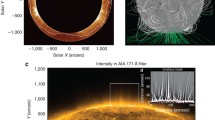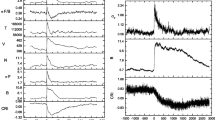Abstract
The simple tilted dipole picture of Corotating Interaction Regions which prevailed during the first polar pass of Ulysses no longer applies since the Sun entered a more active phase. Recent observations show that CIRs still persist, though the large polar coronal holes of solar minimum shrink to smaller areas and move to lower latitudes. We present 3-D simulations for the cosmic-ray intensity variations in a model with non-polar high speed streams. Latitudinal and recurrent time-variations are discussed, but more detailed and realistic simulations are required before quantitative comparisons with observations can be made.
Similar content being viewed by others
References
Balogh, A. and Smith, E. J.: 2001, Space Sci. Rev. 97, 147–160 (this issue).
Burlaga, L. F., McDonald, F. B., Goldstein, M. L., and Lazarus, A. J.: 1985, J. Geophys. Res. 90, 12127.
Chih, P. C. and Lee, M. A.: 1986, J. Geophys. Res. 91, 2903.
Gosling, J. T. and Pizzo, V. J.: 1998, Space Sci. Rev. 89, 21.
McComas, D. J., Gosling, J. T., and Skoug, R. M.: 2001, Space Sci. Rev. 97, 99–103 (this issue).
Kóta, J. and Jokipii, J. R.: 1991, Geophys. Res. Lett. 18, 1797.
Kóta, J. and Jokipii, J. R.: 1998, Space Sci. Rev. 83, 137.
Richardson, I. G., Wibberenz, G., and Cane, H. V.: 1999, J. Geophys. Res. 104, 12549.
Simpson, J. A. et al.: 1999, Science 268, 1097.
Author information
Authors and Affiliations
Rights and permissions
About this article
Cite this article
Kóta, J., Jokipii, J. Cosmic Ray Transport in a Heliospheric Magnetic Field with Non-Polar Coronal Holes. Space Science Reviews 97, 327–330 (2001). https://doi.org/10.1023/A:1011893420841
Issue Date:
DOI: https://doi.org/10.1023/A:1011893420841




